








2024年3月20日,“新中国设计的诞生(1945-1959)”展览开幕式在中央美术学院美术馆2层A展厅开启。本次展览以20世纪40、50年代中国社会的巨变为背景,围绕1945-1959年之间的中国设计与中国现代文明和历史文化之间的关系,从“前进 前进”“视觉革命”“积极的工业化”“人民的时尚”“民族 科学 大众”五个板块,以实物、图像、影像和文献等多种途径展出作品二百余件,系统地呈现中国现代设计史发展中的这个重要阶段。
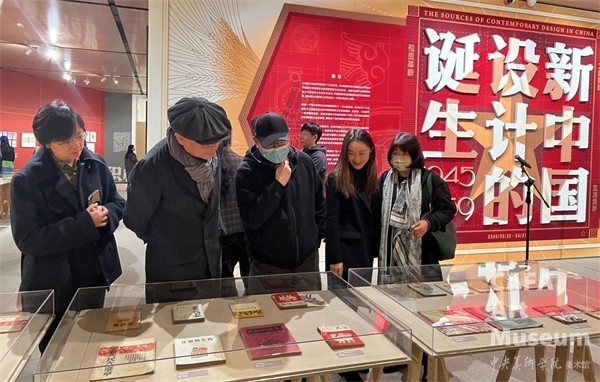

出席开幕式的嘉宾有中央美术学院副院长邱志杰,中国工艺美术馆中国非物质文化遗产馆副馆长苏丹,四川美术学院研究生院院长谢亚平,中国美术学院中国国际设计博物馆馆长张春艳,中央美术学院美术馆馆长靳军、美术馆直属党支部书记韩文超、设计学院院长郝凝辉、造型学科基础部主任白晓刚、艺术设计研究院院长强勇、党委宣传部部长徐新立、融媒体中心主任秦建平、党委宣传部副部长吴琼、实验艺术系党支部副书记陈明强,北京服装学院民族服饰博物馆展陈负责人副研究员胡小妹,中国美术学院中国国际设计博物馆典藏部主任高原,周令钊先生女儿周荣及中央美术学院设计学院师生。

中央美术学院副院长、展览学术主持邱志杰发言
中央美术学院副院长邱志杰在致辞中提到,我们过往的近百年来是整个中国文化和中国艺术经历自我改造、创造出新的人民国家的一整个艰辛的过程,新中国设计应该说是这样的一个奋斗和斗争的过程的一个非常重要的精神成果。他从贾延良先生基于明式家具的汽车设计出发,进一步探讨了国社科“中华传统艺术资源的创新设计转换”的招标课题,凸显了传统艺术在现代设计中的创新价值,并且着重强调了展览中美术字研究书籍的重要性,指出了市场上流行的“武士道字体”对传统文化与艺术美学的侵袭问题。最后,他引用总书记在清华美术学院的讲话中所提及的“美术艺术科学技术相辅相成,相互促进,相得益彰”“要把美术元素注入我们的城乡经济的发展,满足人民群众日益增长的物质美好生活需求”和“以美为媒,推动国际文化交流”三句话来总结这次的展览,认为展览既有跟当时的科学技术的联动,也有为人民生活,为人民创造新的时尚的这种对经济发展的直接的助力,更有塑造国家形象的一种努力,并希望这个展览可以巡回到尽可能多的地方去。

中央美术学院美术馆馆长、展览总监靳军发言
中央美术学院美术馆馆长靳军指出,本次展览的重要性在于它通过设计成果深刻反映了新中国成立前后一二十年间文化和社会的发展过程。靳军馆长谈到,设计在过去曾被称为实用美术,中央美术学院最早设立了实用美术系,后来演变为中央工艺美术学院,致力于推动了社会的视觉和设计产品发展。随着改革开放和经济的快速增长,艺术逐渐融入社会和产业,带动了艺术与产业的深度融合。他进一步表示,本次展览展现了几十年前众多杰出设计创作融入在社会的历史进程中,凸显了与日常生活和产业紧密相连的设计领域,如标志、书籍、产品和服装、汽车等设计在中国现代发展中的重要作用。这些成就不仅为当代设计师和艺术家提供了宝贵的启示,也激励他们探索如何将中国传统艺术元素融入现代生活和工作,以实现与社会整体发展的有机结合。

中央美术学院设计学院院长、展览总监郝凝辉发言
中央美术学院设计学院院长郝凝辉表示,“新中国设计的诞生”展览充分回顾和思考了中国设计的发展历程,同时也对中国设计行业未来的走向进行了深入探索与展望。这个展览中,可以看到自新中国成立以来,设计在推动国家发展方面扮演着至关重要的角色,无论是工业生产的进步、城市规划的变革,还是文化传播的塑造,都与设计紧密相连。新中国设计的诞生,象征着中国踏上了自主、创新的设计之路,这不仅为中国的现代化进程提供了坚实支撑,也为世界设计史增添了新的篇章。因此回顾新中国设计的历史,不仅要观察其形态的演变,更需审视其中蕴含的文化精神、时代精神以及人民精神的传承与创新。并从建国初期的工业设计、宣传海报,到改革开放后的城市规划、商业品牌,再到如今的数字化设计、智能科技,感受到新中国设计的演变展现了丰富多彩的面貌。他还提出,设计不仅关乎外在形式的表达,更是文化认同、社会价值的体现,因此现代设计师肩负着传承与创新的双重使命,既要深入研究中国设计的历史、文化和传统,理解其深层含义,又紧跟时代步伐,积极参与全球设计对话与交流,推动中国设计走向世界舞台。

中央美术学院设计学院教授、展览策展人周博发言
本次展览的策展人、中央美术学院设计学院教授周博指出,鉴于中国地域辽阔、工业中心众多,且并非单一民族的国家,在研究中国设计历史时,必须有全局性的总体史视野和格局。在这样的背景下,如何在限定的时间历史阶段内,实现设计发生地域与设计门类之间的平衡,成为本次展览需要关注的问题。为此,此展览也邀请了中国美术学院和四川美术学院共同参与,以期通过全局的视角来审视中国的设计发展。周博教授强调,本次展览是总体史的框架下,围绕现代化主题来把握中国设计史的叙事脉络,突出设计作为物质和视觉文化对于中国从革命后的农业国向现代化工业国转变过程的呈现。他认为,无论是学者和策展人,都需要思考如何构建叙事框架,因此设计研究工作者们不能仅将目光局限于研究冷战时期的艺术和设计,也不能完全套用西方的叙事文化逻辑;而应该从中国自身的角度出发,构建属于中国本土设计叙事体系,并在此基础上再不断补充、不断完善,以丰富设计的内涵与外延。
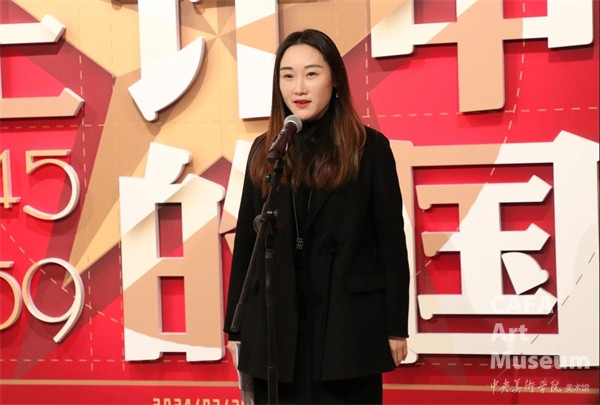
中央美术学院美术馆设计部主任、展览策展人兼设计总监纪玉洁发言
本次展览策展人、设计总监,中央美术学院美术馆设计部主任纪玉洁在发言中谈到中央美术学院美术馆有两种不同学术方向的设计展并行,一种是全球视野下关于当代设计的前瞻性思辨,另一种就是聚焦中国设计史的梳理与建构。两个类型的设计展交替呈现,对于美术学院的设计教育、设计研究乃至面向社会公众的设计美育都有着重要的价值和意义。今年恰逢新中国成立75周年,新文艺座谈会上的讲话发表10周年,回望新中国设计史,策划一个史学梳理和总结的设计展就具备了一种契机和可能。希望本次展览能为我们理解和审视20世纪中国现代设计提供新视角与切入点,从纵向、横向带出更多可思考和学术研究议题,如:中国设计的现代性转型与建构、设计教育的历史沿革、设计的民族风格形成等。她还谈到展览的主视觉设计理念,将锦旗、五星、麦穗、汽车、和平鸽等代表性设计符号融合进行设计,以庄严富丽的金色、红色为主,着重体现历史感、仪式感和向上挺拔的积极调性。同时注重把当代设计审美的意识注入其中,力求以高度的视觉整合诠释新中国设计的诞生。

中央美术学院美术馆副馆长、展览统筹高高主持开幕式
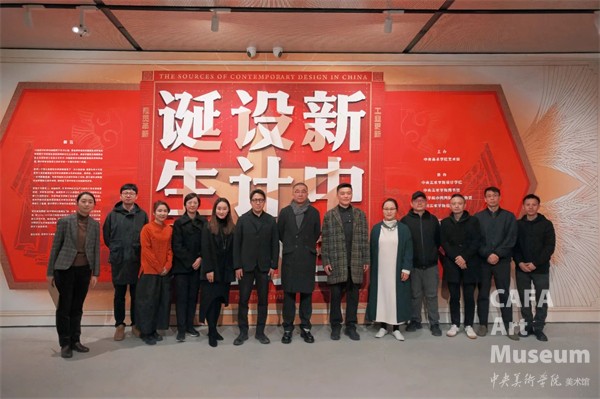
嘉宾合影





展览板块及作品
一、前进 前进

1945年日本战败投降后,中国共产党领导下的陕甘宁、晋察冀等抗日根据地统一改为解放区,并在解放战争中逐步扩大。而在毛泽东文艺思想指引下的延安美术和设计经验,则随着解放军进军全国的步伐很快影响至全国。当然,延安美术对于新中国设计的影响主要体现为以新年画为代表的宣传性平面艺术。随着解放军对全国各大城市的解放和接管,以中国纺织建设公司为代表的官僚资本被没收成为国营经济,而民族资本主义工商业则得到了有效的保护,在中国近代城市工商业的发展中所形成的设计知识和经验也成为新中国设计的重要源泉。

《在毛泽东旗帜下前进!》,张仃,宣传画,77×53.3cm ,1949年,中国美术馆藏

《东北画报 第48期》,东北画报社编 封面摄影:齐观山,刊物,22.7×25.9cm,1949年3月30日,私人收藏

《文艺三十年》,封面设计:张光宇,刊物,13×18.4cm,1949年5月4日,私人收藏

《迅速复工努力生产》,天津区军事管制委员会文化教育部作,宣传画,77x53cm,1949-1950年,中央美术学院图书馆藏

《中国国货公司》,53.4×76.5cm,印刷品,1940年代,私人收藏
二、视觉革命

新中国设计的诞生,在视觉层面上,首先表现为以国旗、国徽为核心的国家视觉形象的确立。齿轮、麦穗、五角星等一系列符号语汇,使新中国设计的图形语言焕然一新,其影响也迅速由政治领域而延展到日常生活。其次,表现为与国家的大政方针密切配合的宣传性图像和装帧新风格的日渐成熟。就中国的现代设计运动而言,这无疑是一场内容广泛的视觉革命。

《曾联松应征国旗设计稿》,曾联松,印刷品,1949年,来源于《中华人民共和国国旗国徽国歌档案》

《国徽设计稿》,中央美术学院国徽设计小组,印刷品,1950年,中国政协文史馆藏

《和平》,张道一,宣传画,77×53cm,1956年,中央美术学院图书馆藏

《庆祝五一劳动节!》,蔡振华,宣传画,77×53cm,1955年,中央美术学院图书馆藏

《中华人民共和国成立十周年(第四组)》纪念邮票的设计手稿,周令钊,印刷品,1959年,中国邮政邮票博物馆藏
三、积极的工业化

对于新中国来说,现代化的核心要义就是把中国从农业国变成工业国,实现工业化。毛泽东在七届二中全会的报告中就明确了关于新中国城市功能的顶层设计,即变消费的城市为生产的城市,《共同纲领》更是强调将重工业作为新中国工业发展的重点,这些原则都在第一个五年计划“积极的工业化”政策中得到坚决地贯彻和落实。可以说,无论是北京、上海等特大城市的规划和改造,还是西安、成都等八大重工业城市的规划和建设,乃至于工矿企业和工人住宅的设计,都是国家工业化顶层设计的延伸。在积极的工业化这个大背景之下,从国之重器到民生日用,新中国设计的大幕徐徐拉开。

《新中国第二代红旗检阅车手绘稿》,贾延良,印刷品,1959年,贾延良收藏
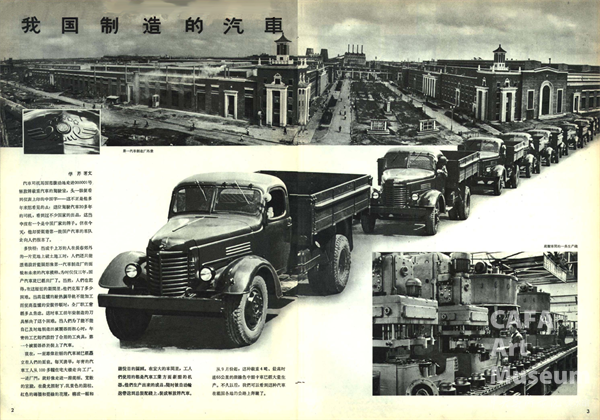
《我国制造的汽车》,《人民画报》1956年第9期,印刷品,1956年9月,私人收藏

《三民电器玻璃制造厂1954年最新样本》,三民电器玻璃制造厂出品,1954年,25x18cm,私人收藏

《上海曹杨新村鸟瞰图》,汪定曾,印刷品,1953年,《建筑设计十年 1949-1959》

《上海市家用化学产品样本》,上海市家用化学品工业同业会所编印,书籍,27.6x19.3cm,1950年代,私人收藏

《各式皮鞋价目表》,南昌市皮鞋生产合作社,印刷品,32.5×46cm,1953年,私人收藏
四、人民的时尚
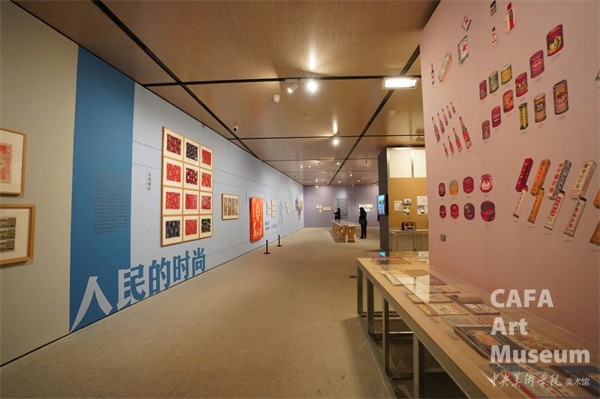
新中国成立之初,以棉纺织业为主体的纺织工业总产值约占全国工业总产值的三分之一,意义非凡。通过没收官僚资本、公私合营和经济改组,纺织行业也完成了社会主义改造,并实行统购统销、选样定产的计划生产管理体制。以上海为中心,诞生了经济、美观、实用的花布设计与丝绸设计创新,纺织业的发展既保障了人民衣着,又通过丝绸等高档纺织品的出口创汇为新中国的经济发展作出了重要贡献。在服装领域,“增产节约”与“旧衣改制”是日常服装设计生产的主题,与此同时,“美化服装运动”与民族风格的探索也在服装设计界和行业内部悄然兴起,时装的面貌呈现出中西混杂、新旧交融的局面,反映了中国人民在物质匮乏的条件下,对美好生活的热烈追求与向往。

《大花样本》,上海纺织品采购供应,样册,53.5×38cm,1955年,私人收藏

《大花样本》,上海纺织品采购供应,样册,53.5×38cm,1955年,私人收藏

《服庄》,上海市服装公司,书籍,25.5×35.5cm,1958年,私人收藏

《上海染织工会信孚印染厂分会新民主主义青年团支部成立大会纪念特刊》,刊物,13×18.7cm,1950年,私人收藏

《旧衣改新装》,上海市服装公司编 上海文化出版社出版,书籍,25.9×18.6cm,1957年,私人收藏

五、民族 科学 大众
毛泽东在《新民主主义论》(1949)中指出,民族的科学的大众的文化,就是中华民族的新文化。这个思想主张后经《共同纲领》确立为新中国文化教育的总纲,对新中国的设计和设计教育的发展也产生了广泛且深远的影响。以北京的十大建筑为代表,新中国的设计师在民族的、科学的、大众的这一总的方针的指导下,坚持实用、经济、美观的基本原则,尊重科学、尊重实践,与建筑师、工程师和建筑工人通力协作,创造出了具有“中国气派,民族风格”的新设计。

《人民大会堂活页画册—人民大会堂》,人民美术出版社,印刷品,37.5×52.7cm,1959年,私人收藏

《人民大会堂宴会厅天花》,常沙娜,印刷品,1958年,艺术家提供

北京展览馆,安德烈耶夫、吉丝洛娃、戴念慈,印刷品, 1954年建成

中国美术馆建筑设计手绘稿,戴念慈主持设计,印刷品,1963年建成,图源于《建筑设计十年 1949-1959》

《和平鸽丝巾》,常沙娜,印刷品。1952年,艺术家提供

新中国设计的诞生
(1945-1959)
展览时间:2024年3月20日-4月21日
展览地点:中央美术学院美术馆2层A展厅
主办:中央美术学院美术馆
协办:中央美术学院设计学院 中央美术学院图书馆 中国美术学院中国国际设计博物馆 四川美术学院设计学院
总策划:高洪 林茂
特邀顾问:常沙娜
学术主持:邱志杰
学术顾问:杭间 宋协伟 许平 段胜峰
展览总监:靳军 韩文超 郝凝辉 张春艳
展览统筹:王春辰 高高
策展人:周博 纪玉洁
特邀策展人:谢亚平 高原
设计总监:纪玉洁
空间设计:张元 闵志伊 张倩媛 王思冬 陈家怡
动态设计:庞明昊 杨永淳
展览助理:谢书旖 凌晨 郭璎萱 于明慧 陈珊珊 许梦伊 黄心仪 刘玉琪 郑林亦心 王堂瑶 周厚堃 应玥琪 张钰莹 廖纯誉 燕阳 陈玥晓 敬茜
展览管理:吴鹏 宿世存
藏品管理:李垚辰 姜 楠 王春玲 崔然然 窦天炜 徐研 梅琦 西华伟
展览宣传:何一沙 吴靖 贺伊飞
官网文宣:王静
智识推广:肖宝珍
公共教育:姚轶群 梁雯 王军
财经事务:杨柳 门婧 寇 蕾
发展推广:孙炜 耿菁华 伊 义 刘佩凝
行政支持:蒋思妤 岳君瑶 张倩 郭旭
后勤维护:陈小华 吕智发
学术支持:国家社科基金艺术学重点项目“新中国设计史研究”(21AG012)课题组
特别鸣谢:中央美术学院档案室 贾延良 周容 唐薇 王人殷 崔冬晖 彦风 戴梦 李世奇
